Casual Companions:
Sidekicks
By Becky Waxman
In a
past editorial I discussed games that show character growth through a
focus on the protagonist's personality, occupation, and specific knowledge
or skills. Now it's time to focus on other types of characters who enliven
game stories -- the protagonist's companions.
Companions are different than the typical
non-player characters (NPCs) encountered in story-based games. Most of the
NPCs that the hero or heroine encounters, for instance, are defined by their
occupation or function -- a town's innkeeper, a ship's captain or a castle's
guard -- and these NPCs fade from the story right after giving a fetch quest
or participating in a conversation.
Companions, on the other hand, travel with
the protagonist, or they show up repeatedly at various important points in
the story. Since they are there over the long haul, the gamer has time to
become acquainted with a companion's background and personality quirks. The
ongoing relationship between companion and hero/heroine is a vital part of
the story.
Casual game companions tend to fall into
three categories -- sidekicks, mentors and teams. This editorial will
describe a sidekick's various roles and then provide examples of casual
adventures and Interactive Hidden Object Games (IHOGs) that illustrate them.
Later editorials will focus on mentors and teams.
*Note: I'm aware that many gamers partner with
their children to play IHOGs. I've put an asterisk in front of each game
that is more appropriate for teens and up, rather than young children.
Further note -- all the games below feature a point-and-click interface and
use a first person perspective.
Sidekicks
A sidekick is a constant companion --
present for the bulk of the story/game -- and he or she is (or at least
begins as) a subordinate. The protagonist hires the sidekick or befriends
him and then lets him tag along. The sidekick provides more situational
responses and more dialogs -- the gamer becomes increasingly aware of a
gradually developing relationship.
A sidekick bolsters, teases, reassures, or
criticizes, making the protagonist look good (or the opposite). The
sidekick's lack of understanding or skill can emphasize (in contrast) the
protagonist's knowledge and talent. Or, alternatively, the sidekick
supplements the protagonist's skill set -- for example, the protagonist's
brains are augmented by the sidekick's brawn. The protagonist usually
performs the key actions in the game -- solving the puzzles, talking to
other characters, using the inventory items -- while the sidekick watches,
comments, or gives hints. (A "sidekick" who does nothing EXCEPT give hints
isn't a true sidekick -- she's just a hint system with a face.)
Sidekicks often function as the plot foil --
the person to whom explanations are given. They sometimes come to the rescue
when the hero/heroine has bitten off more than s/he can chew. Occasionally,
sidekicks are actually more competent than the protagonist -- hiding their
skills until late in the story, or subordinating themselves because they
care about the protagonist.
 Dr.
John Watson -- Faithful Friend
Dr.
John Watson -- Faithful Friend
*Sherlock Holmes and the Hound of the
Baskervilles
The most famous sidekick in English
literature, Arthur Conan Doyle's Dr. Watson appears in several recent
adventure and casual games, many of them (like this one) by adventure game
developer Frogwares. Holmes and Watson are so well known that their
relationship is almost a given. Holmes -- the superior mind, the master at
solving abstruse mysteries. Watson -- the companion supporting Holmes, the
chronicler of his exploits, and the poser of orthodox questions that Holmes
answers with brilliant out-of-the-box responses. Watson humanizes the
terrifyingly cerebral Holmes. He deals generously with people they encounter
and tries to keep the master detective from self-destructing between cases.
In this casual Hound of the Baskervilles
game, Watson is a proper Victorian era gentleman donning a brown suit and
sporting a genial expression and bushy mustache. The game diverges from the
novel almost immediately, dragging Holmes and Watson out of everyday
surroundings and into the realm of supernatural abilities and time travel.
Environments in this IHOG are lavishly
detailed, eerily lit, and (after traveling in time) often blood-splattered.
An interactive map eliminates much of the back-and-forthing required by the
complex investigation. Puzzles include inventory challenges, a wide variety
of mini-games, and using supernatural abilities. Hidden Objects (HO) screens
contain Find Lists with occasional multiples of the same item thrown in.
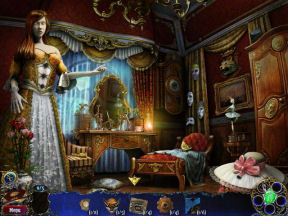
The characters in this game are well defined
(and well voiced during the many cut scenes), and a third character -- Henry
Baskerville -- is so constant a presence that he almost becomes a second
sidekick. The gameplay itself is curiously anonymous. From what I could
tell, it's actually Watson who is applying inventory items, finding objects,
and solving the puzzles in this game -- an unusually active role for a
sidekick. The Baskerville medallion that bestows special powers (strength,
perception, telekinesis, for example) can be used by any of the three main
characters, depending on the circumstances.
We are familiar with Watson and Holmes
parked squarely in the middle of logic and rationality -- and many fans of
the series prefer them there. Still, I found it surprisingly enjoyable to
see the famous detective and his adaptable sidekick venturing out of their
usual intellectual comfort zone.
 Captain
Salvatore Ortiz -- Sarcasm for Hire
Captain
Salvatore Ortiz -- Sarcasm for Hire
Lost Secrets: Bermuda Triangle
Rachel Broadview is a research librarian at
Boston College, when she stumbles across a reference to an ancestor and a
shipwreck in the Bermuda Triangle. Curious to learn more, she travels to
Pequod Key. Hiring Captain Salvatore Ortiz, a handsome but down-on-his-luck
expedition guide, she goes SCUBA diving in a search for the remains of the
good ship Abigail Anne and any evidence that Rachel's ancestor was on board.
The environments in this traditional Hidden
Object Game are exotic in a naturalistic style. Gameplay itself comprises
mostly standard HO screens with a Find List. (The game lacks inventory
challenges.) A handful of mini-games related to seafloor searching add
variety.
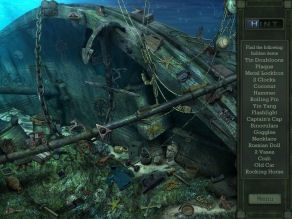
Setting this game apart is the witty banter
and the growing relationship between the geeky librarian and the hunky
captain (the game is unvoiced). Captain Ortiz usually deals with clueless
clients and beautiful, admiring women. He is at first confused when Rachel
is neither. He also assumes, mistakenly, that he knows everything that's
going on in Pequod Key.
By game's end with the "big reveal," Captain
Salvatore's character is ambivalent enough that I was holding my breath,
waiting to see if he was going to turn out to be a hero...or a creep.
 Felly
-- Trusty Subordinate
Felly
-- Trusty Subordinate
Elementals -- The Magic Key
This unusual IHOG is set in the land of
Eiron, the brightly animated, cartoon-like home to the elementals -- spirits
of water, fire, earth, energy, air, and primordial nature. You assume the
role of Albert, an apprentice wizard at the Academy who sets off on a quest
to reassemble the Great Key of Eiron and rescue his sister, who has been
kidnapped by the evil Sibelius.
Albert's sidekick is his valet Felly. Felly
is a creature with purple skin, large green eyes and a monocle. He offers
advice, gives hints, and suggests various ways to approach the fantasy
creatures populating the game. He addresses Albert as "Sir," but also gently
pokes fun at him. The game isn't voiced, but the characters are
distinguished by their personalities -- Albert is eager to take on new
challenges, Felly is polite and rather protective, and Sibelius is smug and
sneering.
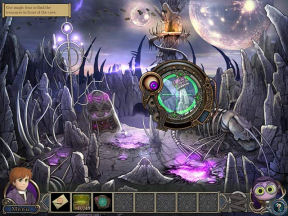
HO challenges are sometimes based on shapes
and other times are in the "find multiple similar items" category. These are
supplemented by frequent inventory challenges. The game also contains a card
game similar to Solitaire and a series of board game challenges that
increase in complexity as skills are added to Albert's repertoire (after the
initial tutorial, the card and board game challenges can be skipped).
As Elementals progresses, it becomes
apparent that Felly either has greater knowledge or more power than he is
prepared to admit. The enchanting visuals and mysterious orchestral music
create a picturesque, fantastical atmosphere as the duo confronts monsters,
villains, and victims in Eiron's magical universe.
 Marbles
-- Talented Monkey
Marbles
-- Talented Monkey
Escape from Thunder Island
Rita James, famed aviator, flies to South
America in search of her father, who has disappeared while exploring the
Lost City of Zenadoo. With Rita are her co-pilot Sebastian, who is good with
airplanes, and her monkey Marbles, who is good at everything else. The game
begins with a Roaring Twenties era newsreel, and includes tongue-in-cheek
dramatic narration, a particularly amusing story element. Thunder Island
is the first in a series created by Big Finish Games, whose developers gave
us the Tex Murphy adventure series.
Rita cuts her way into a naturalistically
rendered (though slightly blurry) tropical rainforest littered with ominous
stone ruins. She is confident that her famous luck will hold. When danger
arises, Rita closes her eyes and hopes for the best, later marveling at her
miraculous escapes. The brushes with death occur in well voiced,
graphic-novel-like cut scenes, in which Marbles (who looks piratical because
of a black eye patch) demonstrates his quick wits and exemplary reflexes.
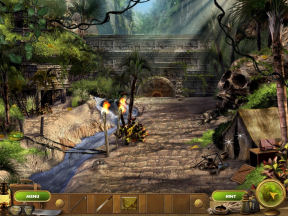
Rita's comments are sassy and humorous and
contain historical and pop culture references. Marbles doesn't speak, though
he makes expressive noises. (He is reminiscent of Gromit from the Wallace &
Gromit claymation films.)
This IHOG provides frequent inventory
challenges, plus mini-game-like puzzles that often involve sequencing, as
Rita and Marbles navigate their way through ruins, forests, and waterways.
It also features some tough jig-saw-puzzle-like challenges. HO screens
contain a Find List, and include certain items that must be assembled before
they can be clicked on.
(Though most of this game is appropriate for
children, there are some encounters with evil demon-like creatures which may
be too intense for very young children.)
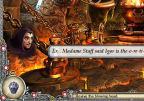 Igor
-- Theoretically Immortal
Igor
-- Theoretically Immortal
The Mystery of the Crystal Portal -- Beyond
the Horizon
A sequel to the
original The Mystery of the Crystal Portal game, Beyond the
Horizon opens as the heroine, Nicole Rankwist, arrives in Atlantis.
Igor, a hunched-over homunculus wearing tattered black robes, eagerly greets
her. Though he physically resembles the Igor character in Young
Frankenstein, this Igor's personality is different -- he is aware of his
odd appearance and is timid and obsequious. He is thrilled to be chosen to
accompany a lively, lovely young woman on her travels.
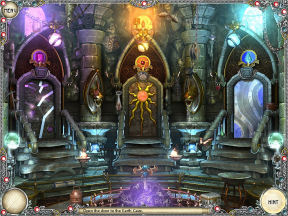
Beyond the Horizon
is an IHOG with splendid, photorealistic graphics and surreal locations. It
features a variety of mini-games, but most of the gameplay consists of HOs,
which are identified via picture icons. The icons are arranged in a series
of wheels, and the wheels are often interdependent -- you can't "solve" one
wheel until you find all the objects in another wheel. The already-tough
difficulty level is heightened by the randomness of the icons (an example --
you must find a horned skull, a lizard, mushrooms, and a cat in order to
pick up a stone hammer). The Hint button recharges slowly.
Despite occasional
frustrations with the gameplay, I found that this game provided an unusually
amusing contrast between the personalities of protagonist and sidekick. (The
game is not voiced.) Nicole is sometimes distracted by the fantastical
surroundings, unusual objects, and odd characters that she meets. Igor stays
focused. Nicole likes to "wing it" and hope for the best. Igor would rather
understand what's going on and figure out what actually works. He politely
contradicts Nicole when her decisions are illogical, or when her ideas are
ridiculously dangerous. Dialogs are well written, and occasionally grant
Igor a scene stealing one-liner.
 Boar
-- Amiable Slacker
Boar
-- Amiable Slacker
*The Jolly Gang's Misadventures in Africa
The cartoon comedy
sidekick is a standard companion type that makes relatively rare appearances
in casual games. The best recent example may be Boar from the ongoing Jolly
Gang saga.
The good news: Boar
is a talented tinkerer when it comes to machines and gadgets. The bad news:
he's a slacker and a wimp, so he doesn't bother to show up until partway
through the game. When he does accompany the intrepid protagonist -- Moxxie
-- on the trip to Africa, he contributes by fixing things and by providing
surprisingly sensible ideas.
Boar and Moxxie look
like giant bugs. You can tell them apart because Boar wears blue overalls,
whereas Moxxie's outfit bares her midriff. At first I thought both
characters were armless (hey, Rayman doesn't seem to miss attached
appendages). But they do have very, very skinny arms. There's a third Jolly
character -- Shaggy -- who mostly appears as a miniature image in some of
the environments. I suppose he is there in spirit.
Though sometimes
helpful, Boar is frequently overwhelmed, tied up, unconscious, and
terrified. This means that Moxxie must rescue and revive him. (An imperiled
sidekick requiring rescue is a common drama-enhancing plot device.)
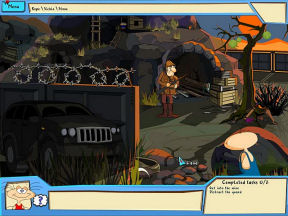
This Hidden Object
Adventure Game (HOAG) has dialog that is less snarky and spicy than that of
the Gang's previous game -- The Jolly Gang's Spooky Adventure. The
humor is still edgy, but more sophisticated than in the previous game. (Wait
-- did I just call this game sophisticated?) The graphics are cartoon-like,
with a primitive charm. The story advances through graphic novel panels.
The characters'
high-pitched voices aren't in English, but rather in a rapid-fire language
supplemented by English subtitles. This approach works well with dialog that
is out-of-the-box anyway. The English translation is competent, without too
many items confused. (Once Boar was labeled as a board -- intentionally, I
presume.)
Misadventures in Africa leans
toward a higher difficulty than the typical casual game and I resorted to
the Hint button often. Challenges are on the wacky side and include using
inventory items, interpreting symbols and codes, and playing mini-games. You
can elect to make the game easier or harder by choosing to have the game
list the items available in each location (or not). The difficulty level can
be adjusted at any time.
Of all the games I
played for this editorial, this one had me grinning and shaking my head the
most. It's outlandish and clever. I hope we see more of these dysfunctional
characters in a hinted-at sequel.
Two's Company
Having played many
casual games where the hero/heroine goes solo except for encounters with
strangers along the way, I find character interaction more satisfying with a
sidekick. I'd rather have the company of a character who I can get to know
well, rather than twenty different characters who spout four or five lines
of dialog and then disappear.
Some of the reasons:
a consistent relationship between a protagonist and sidekick inevitably
reveals more facets of personality, as the companions encounter conflicts on
their journey and rub off one another's "rough edges." In these stories,
there's simply more time spent illustrating the character strengths,
foibles, and typical reactions. Dialog between characters is more personable
and spontaneous than, for instance, reading the heroine's thoughts in a
diary (a diary is frequently a substitute for a constant companion in casual
games). And finally, it may be human nature to care more about the
protagonist while witnessing exchanges that show that someone else cares
too.
A quick word about
voiceovers (or the lack thereof). Games that lack voiceovers must rely much
more on the game's writer, because the quality of the characterizations
relies entirely on the unspoken word. Characters who look different, act
differently, and perform different functions should NOT have dialogs that
are virtually interchangeable. It's much easier to distinguish and identify
personality if the game contains voiceovers -- a good voiceover artist can
evoke personality despite generic dialog writing. Of course, dull voiceovers
can make the characters even less appealing than they would be if they were
left silent.
Coming up Next
Look to this space to see more discussion of casual
games and companionship. Next up: Casual Companions -- Mentors.
**Note: some of the ideas
for this article were influenced by Character Development and
Storytelling for Games, a book by Lee Sheldon.
copyright © 2011
GameBoomers